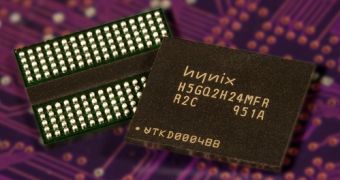Today, news has been mainly about the sudden release of the Intel Atom N450 Pineview processor. Immediately after the launch, companies like ECS, MSI and Dell raced to show off their respective hardware products which either are meant to be used with or already make us of the processor. Hynix, however, distinguished itself from the fold by introducing a product which not only has nothing to do with the Pineview, at least not directly, but is also a breakthrough in itself. It seems that, just a month after it had its 40nm process validated by Intel, the company already finished working on the world's first 2Gb GDDR5 memory chip based on the 40nm manufacturing process.
As it has been the case with most of the recent hardware releases, which have done their best to include a power efficiency feature, however small, the new product boasts both an increase in performance and a decrease in power consumption. The new memory chip from Hynix operates on 1.35V and can reach 7Gbps when used with a 32 bit I/O. This translates into an impressive memory clock of 7000 MHZ. Not only that but the actual power consumption of the chip is 20 percent lower than that of similar chips based on the 50nm manufacturing process.
The DRAM module is, unfortunately, just the prototype and mass production is not set to start before the second half of 2010. Still, when it does enter that stage, most next-generation graphics products, including both the Fermi-based GPUs and AMD's next-generation adapters, will likely use the chips in their construction.
Intel's Pineview has already set the basis for next-generation mobile computing and Hynix's DRAM chips will likely help in the setting of a new graphics memory standard for the high-end graphics market. The frequency of 7000 MHz alone would be enough to grab the full attention of knowledgeable end-users and the memory density definitely provides a strong foundation for future graphics technology developments.

 14 DAY TRIAL //
14 DAY TRIAL //